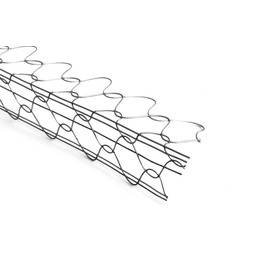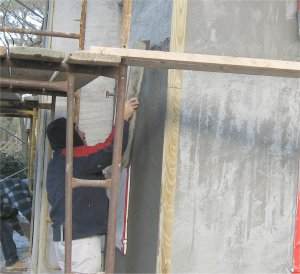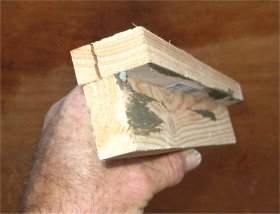Questions I couldn't get the drop down menu to work: plastic corner beads in Florida Cold joints Adobe blocks
Corner beads for plaster and stucco
The first corner beads came out in the late 1930's
I got this from a house in Washington, DC that was built about 1938. These beads were used on the interior plaster. The exterior stucco didn't have any beads. I haven't ever seen metal beads on any exterior stucco done before the 1950's. The metal wasn't expanded, but folded over and holes punched for mortar keys and nail holes.
This style of bead was still made up until about 10 years ago. They are great for arches.
Veneer plaster beads
Metal corner beads for veneer plaster, also called "mini beads", or type 900 beads, are the same size as a drywall corner bead, with a 1 1/4" flange.
The expanded mesh is much finer than a conventional plaster bead, which has a 3 inch flange.
If a drywall bead is substituted for veneer plaster, the flange should be painted with a plaster bonder before plaster application.
Back to stucco:

Quik corner for stucco has a woven wire flange.
Unlike conventional plaster beads, the corner is reinforced with wires, and is made to be completed embedded in the brown coat.
These are made for exterior use.
Interior beads on the exterior:
After 4 years, type 1-A corner beads are already falling apart.
This chimney is on a fake "one-coat" stucco application on a Toll Brothers house.
The application is a thin cement basecoat with a synthetic finish, which is a rubbery paint with plastic sand.
Toll brothers pawns this off as real stucco to the public. It is sad to see a product that falls apart in 4 years.
These one coat systems are notorious for lawsuits for water infiltration.

Before metal beads were invented, the arisses (outside corners) on stucco were done by stripping.
A wood strip is nailed to the wall and the wall is straightened to the wood strip.
When one side sets up, the strip is put on the other side.
On historic interior plaster, we also strip the finish coat.

A simple homemade tool can be made to true up the arris. These work well on short areas.
A tool like this was used on the finish coat on this circa 1928 house.
I don't know about plastic corner beads. I have never used them. I have seen a lot of long failure of plastic components, and I think they don't last in a cold climate. In Florida, they probably are an excellent solution to stop rust, and seems they hold up better in the warm climate.